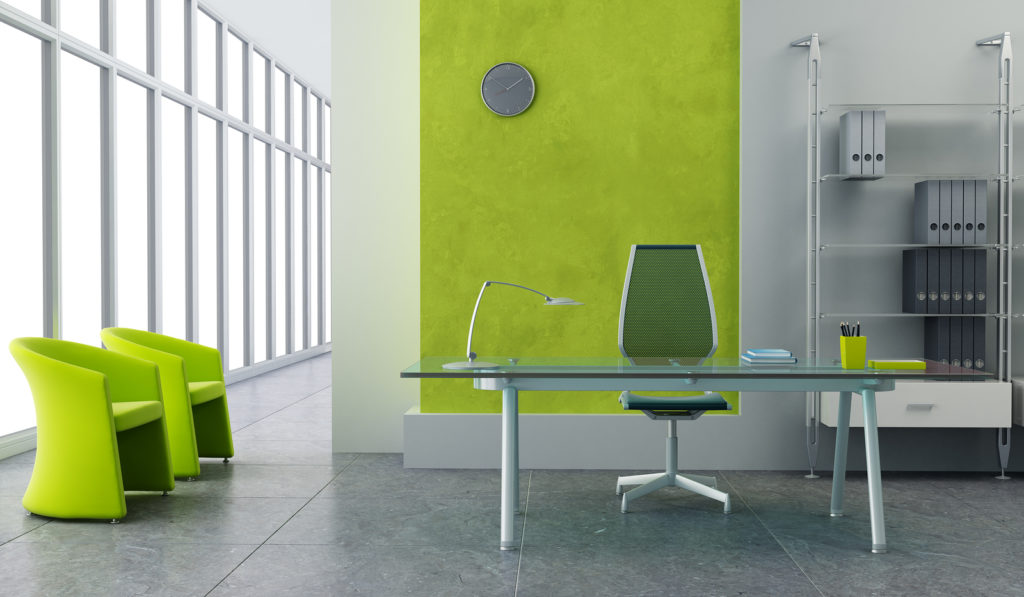
Sustainability in the workplace is about achieving energy efficiency or, in other words, using the minimum amount of energy to perform everyday tasks and to create a comfortable, healthy environment for employees. Even small steps towards a ‘green’ office can improve the health and productivity of the workforce which, in turn, translates into tangible financial gain, so sustainability has environmental, social and economic benefits.

Materials & Waste
Sustainable, ‘green’ office materials may cost fractionally more than the standard alternatives, but you will find that you are more than amply compensated for any price difference by your reduction in environmental pollution and waste. The fully ‘paperless’ office remains a pipe dream, but you can start by switching to 100% recycled paper and envelopes, processed and colored by environmentally-friendly methods, with little or no chlorine bleaching. When it comes to printing documents, print only what you need and print on both sides of the paper, recycle your printer cartridges and replace them with similarly recycled versions. Refillable pens, made from recycled materials, are readily available and are a cost-effective alternative to traditional, disposable pens. Of course, sustainable office stationery and supplies is just a start; other ways to improve sustainability in the workplace you might like to consider include sustainable office furniture, such as second-hand, refurbished or recycled furniture, to further reduce your carbon footprint.
Natural Lighting
A sustainable workplace should, ideally, admit a sufficient, but not excessive, amount of natural daylight through windows, skylights and other glazed surfaces. Of course, direct sunlight can cause glare and increase the temperature inside a building – a.k.a. ‘solar gain’ – which, in turn, increases the cooling demand, or load. Nevertheless, a correctly designed daylighting system distributes light evenly throughout a workplace, avoiding any such problems, reducing the need for artificial lighting and, possibly, reducing, or avoiding, the need for mechanical ventilation. Collectively, these benefits can reduce energy consumption by up to 30%. Natural daylight also has positive effects on the workforce, increasing focus and productivity by up to 20%, according to some studies, with a corresponding ‘knock-on’ effect on the bottom line.
Artificial Lighting
Artificial lighting is a ‘necessary evil’ in any office, but you can minimise energy use by replacing all traditional fluorescent, halogen or incandescent lighting with energy-efficient LED – short for ‘Light Emitting Diode’ – lighting. LED bulbs are not only 50% more energy efficient than even fluorescent bulbs, but also last two or three times longer, reach full brightness immediately and project no heat. Artificial lighting should, of course, provide enough light to allow employees to work comfortably, but not so much as to produce harmful glare, which also wastes energy. As part of your sustainability strategy, make sure that light switches are accessible and easily understood – by labeling, if necessary – and educate your staff to switch lights off when not required.
Electricity Management
Office equipment, including computers, is often left on, or inactive or passive ‘standby’ mode, which consumes nearly as much electricity, when not in use, over the weekend and during holidays. Encouraging, and reminding, employees to switch off all office equipment – not just computers, but photocopiers, printers or anything else that consumes electricity – when not in use is just one of many energy-saving tips at the workplace. Dimming computer monitors and disabling screen savers are other ways to conserve energy in the workplace. Consider replacing desktop computers and laser jet printers with their laptop and inkjet counterparts, which typically consume around 90% less energy or even more in some cases.
Indoor Air Quality & Air Conditioning
Poor indoor air quality can impair health and productivity in the workplace. Air quality is measured by determining physical properties, such as temperature and humidity, and pollution concentration. Airborne pollution includes gases, such as carbon monoxide, particulate matter, and volatile organic compounds. Volatile organic compounds originate from many everyday sources, including some building materials, cleaning chemicals, and solvent-based paints.
Effective building design and an adequate ventilation strategy are key factors in improving indoor air quality. However, densely populated offices may require extra mechanical cooling and, under such circumstances, an energy-efficient air conditioning service is often the best way to minimise airborne pollutants and allow fresh, clean air to circulate freely. Correctly designed and maintained, air conditioning systems can reduce carbon emissions, as well as life-cycle and running costs.
